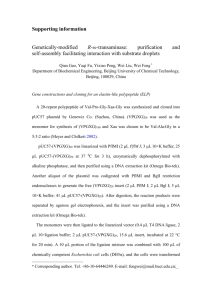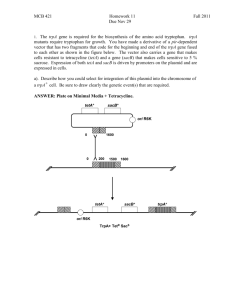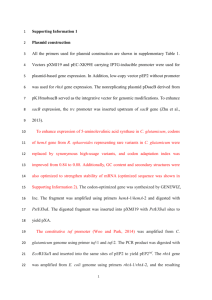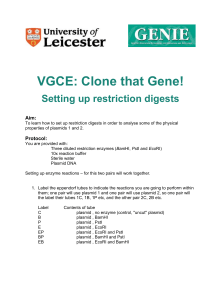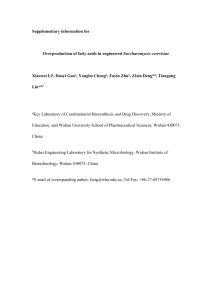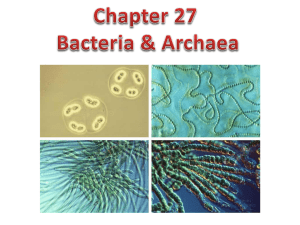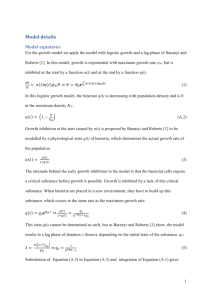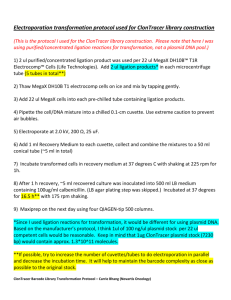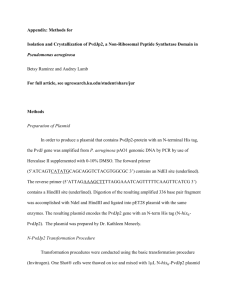Text S1: Supporting Methods
advertisement
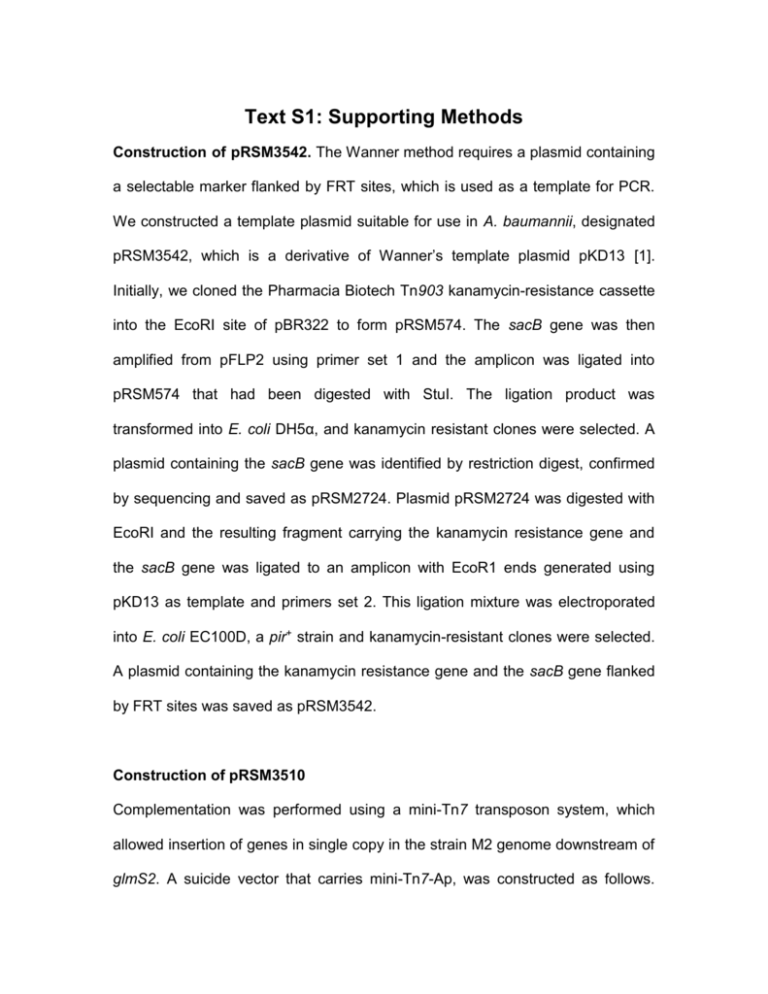
Text S1: Supporting Methods Construction of pRSM3542. The Wanner method requires a plasmid containing a selectable marker flanked by FRT sites, which is used as a template for PCR. We constructed a template plasmid suitable for use in A. baumannii, designated pRSM3542, which is a derivative of Wanner’s template plasmid pKD13 [1]. Initially, we cloned the Pharmacia Biotech Tn903 kanamycin-resistance cassette into the EcoRI site of pBR322 to form pRSM574. The sacB gene was then amplified from pFLP2 using primer set 1 and the amplicon was ligated into pRSM574 that had been digested with StuI. The ligation product was transformed into E. coli DH5α, and kanamycin resistant clones were selected. A plasmid containing the sacB gene was identified by restriction digest, confirmed by sequencing and saved as pRSM2724. Plasmid pRSM2724 was digested with EcoRI and the resulting fragment carrying the kanamycin resistance gene and the sacB gene was ligated to an amplicon with EcoR1 ends generated using pKD13 as template and primers set 2. This ligation mixture was electroporated into E. coli EC100D, a pir+ strain and kanamycin-resistant clones were selected. A plasmid containing the kanamycin resistance gene and the sacB gene flanked by FRT sites was saved as pRSM3542. Construction of pRSM3510 Complementation was performed using a mini-Tn7 transposon system, which allowed insertion of genes in single copy in the strain M2 genome downstream of glmS2. A suicide vector that carries mini-Tn7-Ap, was constructed as follows. Briefly, the mini-Tn7 cassette was amplified from pUC18T-Tn7-Gm [2] using primer set 7. The amplicon was digested with NotI, ligated into pSMART LC-Kan (Lucigen, Middleton, WI), that had been digested with NotI, then the ligation mix was transformed into E. coli DH5α. Transformants were selected on L-agar containing kanamycin (20 µg/ml) and gentamicin 10 µg/ml. A plasmid from a kanamycin- and gentamicin-resistant clone was verified by sequencing and saved as pRSM3508. The aacC1 gene in pRSM3508 was replaced with bla from pGEM-T-Ez (Promega) as follows. Primer set 8 was used together with pGEM-TEz as template to amplify a product that contained bla from pGEM-T-Ez flanked by 50 bp of homology to a region upstream and downstream of aacC1 in pRSM3508. The amplicon and pRSM3508 were electroporated into E. coli DY380. After heat shock, as described above to induce the λ recombination system, clones were identified by plating on L-agar with ampicillin (100 µg/ml) and kanamycin (20 µg/ml). Plasmid from a single clone was verified by restriction digestion and sequencing, then saved as pRSM3509. The plasmid pRSM3509 contains a mini-Tn7-Ap transposon with a multiple cloning site for introduction of genes back into the Acinetobacter genome. pKNOCK-Gm [3] is a suicide vector that can propagate in E. coli strains that express the pir gene product but not in A. baumannii. We introduced the miniTn7-Ap cassette into a pKNOCK-Gm derivative expressing a kanamycin resistance gene. This plasmid contains a multiple cloning site that is similar to the multiple cloning site in the mini-Tn7-Ap cassette. Thus, the multiple cloning site in the plasmid backbone of pKNOCK-Km was removed by digestion with XbaI and KpnI. The ends of this digestion product were polished using the End-It DNA Repair Kit (Epicentre) and the linearized plasmid was self-ligated and transformed into E. coli EC100D by electroporation. A single clone was verified by restriction digest and saved as pRSM3506. The mini-Tn7-Ap cassette was introduced into pRSM3506 as follows. An amplicon that contained mini-Tn7-bla, generated by PCR with primer set 7 and pRSM3509, was digested with NotI and ligated into pRSM3506 that had been digested with NotI. Ligation mixtures were transformed into E. coli EC100D by electroporation and plated on L-agar containing ampicillin (50 µg/ml) and kanamycin (20 µg/ml). Plasmid from a single colony was verified by restriction digest and sequencing, then saved as pRSM3510. References 1. Datsenko KA, Wanner BL (2000) One-step inactivation of chromosomal genes in Escherichia coli K-12 using PCR products. Proc Natl Acad Sci U S A 97: 66406645. 2. Choi KH, Gaynor JB, White KG, Lopez C, Bosio CM, et al. (2005) A Tn7-based broad-range bacterial cloning and expression system. Nat Methods 2: 443-448. 3. Alexeyev MF (1999) The pKNOCK series of broad-host-range mobilizable suicide vectors for gene knockout and targeted DNA insertion into the chromosome of gram-negative bacteria. Biotechniques 26: 824-826, 828.

